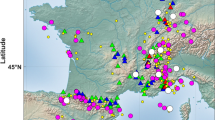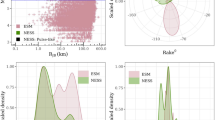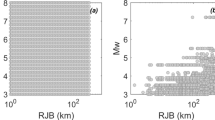Abstract
Typical seismic ground-motion models predict the response spectral ordinates (GMM-SA), which are the damped responses of a suite of single-degree-of-freedom oscillators. Response spectra represent the response of an idealized structure to input ground-motion, but not the physics of the actual ground-motion. To complement the regionally adaptable GMM-SA of Kotha et al. (2020), we introduce a model capable of predicting Fourier amplitudes (GMM-FA); developed from the Engineering Strong Motion (ESM) dataset for pan-Europe. This GMM-FA reveals the very high variability of high frequency ground-motions, which are completely masked in a GMM-SA. By maintaining the development strategies of GMM-FA identical to that of the GMM-SA, we are able to evaluate the physical meaning of the spatial variability of anelastic attenuation and source characteristics. We find that a fully data-driven geospatial index, Activity Index (AIx), correlates well with the spatial variability of these physical effects. AIx is a fuzzy combination of seismicity and crustal parameters, and can be used to adapt the attenuation and source non-ergodicity of the GMM-FA to regions and tectonic localities sparsely sampled in ESM. While AIx, and a few other parameters we touch upon, may help understand the spatial variability of high frequency attenuation and source effects, the high frequency site-response variability—dominating the overall aleatory variance—is yet unresolvable. With the rapid increase in quantity and quality of ground-motion datasets, our work demonstrates the need to upgrade regionalization techniques, site-characterisation, and a paradigm shift towards Fourier ground-motion models to complement the traditional response spectra prediction models.
















Similar content being viewed by others
References
Abrahamson NA, Silva WJ, Kamai R (2014) Summary of the ASK14 ground motion relation for active Crustal regions. Earthq Spectra. 30:1025–1055. https://doi.org/10.1193/070913eqs198m
Akkar S et al (2014) Reference database for seismic ground-motion in Europe (RESORCE). Bull Earthq Eng 12:311–339. https://doi.org/10.1007/s10518-013-9506-8
Al Atik L, Abrahamson N, Bommer JJ, Scherbaum F, Cotton F, Kuehn N (2010) The variability of ground-motion prediction models and its components. Seismol Res Lett 81:794–801
Alexis R, Sokos E, Lefils V, Briole P (2021) Seasonal variations in amplitudes and resonance frequencies of the HVSR amplification peaks linked to groundwater. Geophys J Int
Ancheta TD et al (2014) NGA-West2 database. Earthq Spectra 30:989–1005
Atik LA, Youngs RR (2014) Epistemic uncertainty for NGA-West2 models. Earthq Spectra. 30:1301–1318
Bard P-Y, Bora SS, Hollender F, Laurendeau A, Traversa P (2019) Are the Standard V S-Kappa Host-to-Target Adjustments the Only Way to Get Consistent Hard-Rock Ground Motion Prediction? Pure and Applied Geophysics:1–20
Basili R et al. (2019) NEAMTHM18 Documentation: the making of the TSUMAPS-NEAM Tsunami Hazard Model 2018
Bates D, Mächler M, Bolker B, Walker S (2014) Fitting linear mixed-effects models using lme4 arXiv preprint https://arxiv.org/pdf/1406.5823.pdf
Bayless J, Abrahamson NA (2019a) An empirical model for the interfrequency correlation of epsilon for fourier amplitude spectra. Bull Seismol Soc Am 109:1058–1070
Bayless J, Abrahamson NA (2019) Summary of the BA18 Ground-Motion Model for Fourier Amplitude Spectra for Crustal Earthquakes in California. Bull Seismol Soc Am. 109:2088–2105
Bindi D, Cotton F, Kotha SR, Bosse C, Stromeyer D, Grünthal G (2017a) Application-driven ground motion prediction equation for seismic hazard assessments in non-cratonic moderate-seismicity areas. J Seismolog 21:1201–1218. https://doi.org/10.1007/s10950-017-9661-5
Bindi D, Kotha S-R, Weatherill G, Lanzano G, Luzi L, Cotton F (2019) The pan-European engineering strong motion (ESM) flatfile: consistency check via residual analysis. Bull Earthquake Eng. 17:583–602
Bindi D, Kotha S (2020) Spectral decomposition of the Engineering Strong Motion (ESM) flat file: regional attenuation, source scaling and Arias stress drop. Bull Earthq Eng. 1–26
Bindi D, Parolai S, Grosser H, Milkereit C, Karakisa S (2006) Crustal attenuation characteristics in northwestern Turkey in the range from 1 to 10 Hz. Bull Seismol Soc Am. 96:200–214
Bindi D, Picozzi M, Spallarossa D, Cotton F, Kotha SR (2019) Impact of magnitude selection on aleatory variability associated with ground-motion prediction equations: part II—analysis of the between-event distribution in Central Italy. Bull Seismol Soc Ama 109:251–262
Bindi D, Spallarossa D, Pacor F (2017b) Between-event and between-station variability observed in the Fourier and response spectra domains: comparison with seismological models. Geophys J Int 210:1092–1104
Bindi D, Zaccarelli R, Kotha SR (2021) Local and moment magnitude analysis in the ridgecrest region, California: impact on interevent ground-motion variability. Bull Seismol Soc Am. 111:339–355
Bommer JJ et al (2015) A SSHAC level 3 probabilistic seismic hazard analysis for a new-build nuclear site in South Africa. Earthq Spectra. 31:661–698
Boore DM, Di Alessandro C, Abrahamson NA (2014a) A generalization of the double-corner-frequency source spectral model and its use in the SCEC BBP validation exercise. Bull Seismol Soc Am 104:2387–2398
Boore DM, Stewart JP, Seyhan E, Atkinson GM (2014) NGA-West2 equations for predicting PGA, PGV, and 5% damped PSA for shallow crustal earthquakes. Earthq Spectra. 30:1057–1085
Bora SS, Cotton F, Scherbaum F (2019) NGA-west2 empirical fourier and duration models to generate adjustable response spectra. Earthq Spectra. 35:61–93. https://doi.org/10.1193/110317eqs228m
Bora SS, Cotton F, Scherbaum F, Edwards B, Traversa P (2017) Stochastic source, path and site attenuation parameters and associated variabilities for shallow crustal European earthquakes. Bull Earthq Eng. 15:4531–4561. https://doi.org/10.1007/s10518-017-0167-x
Bora SS, Scherbaum F, Kuehn N, Stafford P (2014) Fourier spectral-and duration models for the generation of response spectra adjustable to different source-, propagation-, and site conditions. Bull Earthq Eng 12:467–493
Bora SS, Scherbaum F, Kuehn N, Stafford P (2016) On the relationship between fourier and response spectra: implications for the adjustment of empirical ground-motion prediction equations (GMPEs). Bull Seismol Soc Am 106:1235–1253
Brune JN (1970) Tectonic stress and the spectra of seismic shear waves from earthquakes. J Geophys Res 75:4997–5009
Campbell KW, Bozorgnia Y (2014) NGA-west2 ground motion model for the average horizontal components of PGA, PGV, and 5% damped linear acceleration response spectra. Earthq Spectra 30:1087–1115. https://doi.org/10.1193/062913eqs175m
Chen Y-S, Weatherill G, Pagani M, Cotton F (2018) A transparent and data-driven global tectonic regionalization model for seismic hazard assessment. Geophys J Int 213:1263–1280
Chiou BS-J, Youngs RR (2014) Update of the Chiou and Youngs NGA model for the average horizontal component of peak ground motion and response spectra. Earthq Spectra. 30:1117–1153
Chounet A, Vallée M, Causse M, Courboulex F (2018) Global catalog of earthquake rupture velocities shows anticorrelation between stress drop and rupture velocity. Tectonophysics 733:148–158
Cong L, Mitchell B (1998) Lg coda Q and its relation to the geology and tectonics of the Middle East. In: Q of the Earth: Global, Regional, and Laboratory Studies. Springer, pp 563–585
Cotton F, Pousse G, Bonilla F, Scherbaum F (2008) On the discrepancy of recent European ground-motion observations and predictions from empirical models: Analysis of KiK-net accelerometric data and point-sources stochastic simulations. Bull Seismol Soc Am 98:2244–2261
Dawood HM, Rodriguez-Marek A (2013) A method for including path effects in ground-motion prediction equations: an example using the Mw 9.0 Tohoku earthquake aftershocks. Bull Seismol Soc Am. 103:1360–1372
Diaferia G, Cammarano F, Faccenna C (2019) Thermal structure of a vanishing subduction system: an example of seismically-derived crustal temperature along the Italian peninsula. Geophys J Int 219:239–247
Douglas J (2018) Calibrating the backbone approach for the development of earthquake ground motion models Best Practice in Physics-based Fault Rupture Models for Seismic Hazard Assessment of Nuclear Installations: Issues and Challenges Towards Full Seismic Risk Analysis
Faccioli E, Paolucci R, Vanini M (2015) Evaluation of probabilistic site-specific seismic-hazard methods and associated uncertainties, with applications in the Po Plain, northern Italy. Bull Seismol Soc Am. 105:2787–2807
Fukushima Y (1996) Scaling relations for strong ground motion prediction models with M 2 terms. Bull Seismol Soc Am. 86:329–336
Garnier S (2019) Viridis: Default color maps from “matplotlib”. 2018 URL https://github.com/sjmgarnier/viridis R package version 03 4:27
Goulet C et al. Effective amplitude spectrum (EAS) as a metric for ground motion modeling using Fourier amplitudes. In: 2018 Seismology of the Americas Meeting, 2018
Grad M, Tiira T, Group EW (2009) The Moho depth map of the European Plate. Geophys J Int. 176:279-292
Grünthal G, Wahlström R (2012) The European-mediterranean earthquake catalogue (EMEC) for the last millennium. J Seismol. 16:535–570
Hollender F, Roumelioti Z, Maufroy E, Traversa P, Mariscal A (2020) Can we trust high-frequency content in strong-motion database signals? Impact of housing, coupling, and installation depth of seismic sensors. Seismol Resh Lett 91:2192–2205
Holmgren JM, Atkinson GM (2018) Effect of uncertainty in source parameters on ground-motion variability for potentially induced earthquakes in the central United States. Seismol Res Lett 89:702–711. https://doi.org/10.1785/0220170208
Huber PJ (1992) Robust estimation of a location parameter. In: Breakthroughs in statistics. Springer, pp 492–518
Jacoby WG (2000) Loess: a nonparametric, graphical tool for depicting relationships between variables. Electoral Stud. 19:577–613
Jarvis A, Reuter H, Nelson A, Guevara E (2008) Hole-Filled Seamless SRTM Data V4: International Centre for Tropical Agriculture (CIAT): http srtm csi cgiar org, accessed 31
Kahle D, Wickham H, Kahle MD (2019) Package ‘ggmap’
Kohrangi M, Kotha SR, Bazzurro P (2020) Impact of Partially Non-Ergodic Site-specific Probabilistic Seismic Hazard on Risk Assessment of Single Buildings. Earthquake spectra (in-review)
Koller M (2016) robustlmm: an R package for robust estimation of linear mixed-effects models. J stat softw 75:1–24
Kotha SR, Bindi D, Cotton F (2016) Partially non-ergodic region specific GMPE for Europe and Middle-East. Bull Earthq Eng 14:1245–1263
Kotha SR, Bindi D, Cotton F (2017) From ergodic to region- and site-specific probabilistic seismic hazard assessment: method development and application at european and middle eastern sites. Earthquake Spectra 33:1433–1453. https://doi.org/10.1193/081016EQS130M
Kotha SR, Cotton F, Bindi D (2018) A new approach to site classification: mixed-effects ground motion prediction equation with spectral clustering of site amplification functions. Soil Dyn Earthq Eng. https://doi.org/10.1016/j.soildyn.2018.01.051
Kotha SR, Cotton F, Bindi D (2019) Empirical models of shear-wave radiation pattern derived from large datasets of ground-shaking observations. Sci Rep. 9
Kotha SR, Weatherill G, Bindi D, Cotton F (2020) a regionally adaptable ground-motion model for shallow crustal earthquakes in Europe. Bull Earthq Eng 18:4091–4125. https://doi.org/10.1007/s10518-020-00869-1
Kowsari M, Halldorsson B, Hrafnkelsson B, Snæbjörnsson JÞ, Jónsson S (2019) Calibration of ground motion models to Icelandic peak ground acceleration data using Bayesian Markov Chain Monte Carlo simulation. Bull Earthq Eng 17:2841–2870
Kuehn NM, Abrahamson NA (2017) The effect of uncertainty in predictor variables on the estimation of ground-motion prediction equations. Bull Seismol Soc Am 108:358–370. https://doi.org/10.1785/0120170166
Kuehn NM, Scherbaum F (2016) A partially non-ergodic ground-motion prediction equation for Europe and the Middle East. Bull Earthq Eng 14:2629–2642
Lanzano G et al. (2018) The pan-European engineering strong motion (ESM) flatfile: compilation criteria and data statistics. Bull Earthq Eng. 1–22
Loviknes K, Kotha SR, Cotton F, Schorlemmer D (2021) Testing nonlinear amplification factors of ground-motion models. Bull Seismol Soc Am 111:2121–2137. https://doi.org/10.1785/0120200386
Lu Y, Stehly L, Paul A, Group AW (2018) High-resolution surface wave tomography of the European crust and uppermost mantle from ambient seismic noise. Geophys J Int 214:1136–1150
Mayor J, Traversa P, Calvet M, Margerin L (2018) Tomography of crustal seismic attenuation in metropolitan France: implications for seismicity analysis. Bull Earthq Eng 16:2195–2210
Mitchell BJ, Cong L, Ekström G (2008) A continent‐wide map of 1‐Hz Lg coda Q variation across Eurasia and its relation to lithospheric evolution. J Geophys Res: Solid Earth. 113
Mucciarelli M, Gallipoli MR, Lizza C, Vignola L (2017) Site condition at accelerometric stations in Southern Italy: observations gained from peculiar cases. Bull Earthq Eng 15:2367–2376
Péquegnat C, Guéguen P, Hatzfeld D, Langlais M (2008) The French accelerometric network (RAP) and national data centre (RAP-NDC). Seismol Res Lett 79:79–89
Perrin C, Manighetti I, Ampuero JP, Cappa F, Gaudemer Y (2016) Location of largest earthquake slip and fast rupture controlled by along-strike change in fault structural maturity due to fault growth Journal of Geophysical Research: Solid. Earth 121:3666–3685
Pilz M, Cotton F (2019) Does the one-dimensional assumption hold for site response analysis? a study of seismic site responses and implication for ground motion assessment using kik-net strong-motion. Data Earthq Spectra 35:883–905
Pilz M, Cotton F, Zaccarelli R, Bindi D (2019) Capturing Regional Variations of Hard‐Rock Attenuation in Europe Bulletin of the Seismological Society of America
R Software Team (2013) R foundation for statistical computing Vienna, Austria 3
Radiguet M, Cotton F, Manighetti I, Campillo M, Douglas J (2009) Dependency of near-field ground motions on the structural maturity of the ruptured faults. Bull Seismol Soc Am 99:2572–2581
Ritsema J, Deuss aA, Van Heijst H, Woodhouse J, (2011) S40RTS: a degree-40 shear-velocity model for the mantle from new Rayleigh wave dispersion, teleseismic traveltime and normal-mode splitting function measurements. Geophys J Int 184:1223–1236
Rodriguez-Marek A et al (2013) A model for single-station standard deviation using data from various tectonic regions. Bull Seismol Soc Am 103:3149–3163
Roumelioti Z, Hollender F, Guéguen P (2020) Rainfall-induced variation of seismic waves velocity in soil and implications for soil response: what the ARGONET (Cephalonia, Greece) vertical array data reveal. Bull Seismol Soc Am 110:441–451
Sahakian V, Baltay A, Hanks T, Buehler J, Vernon F, Kilb D, Abrahamson N (2019) Ground‐Motion Residuals, Path Effects, and Crustal Properties: A Pilot Study in Southern California Journal of Geophysical Research: Solid Earth
Stafford PJ (2017) Interfrequency correlations among fourier spectral ordinates and implications for stochastic ground-motion simulationinterfrequency correlations among fourier spectral ordinates and implications. Bull Seismol Soc Am 107:2774–2791
Stewart JP (2000) Variations between foundation-level and free-field earthquake ground motions. Earthq Spectra 16:511–532
Traversa P et al. (2020) RESIF RAP and RLBP dataset of earthquake ground motion in mainland France Seismological Research Letters
Venables W, Ripley B (2002) Modern applied statistics (Fourth S., editor) New York. Springer
Weatherill G, Crowley H, Lemoine A, Roullé A, Tourlière B, Kotha SR, Cotton F (2020a) Modelling Seismic Site Response at Regional Scale for the 2020 European Seismic Risk Model (ESRM20). Bulletin of Earthquake Engineering in-preparation
Weatherill G, Kotha SR, Cotton F (2020) Re-thinking Site Amplification in Regional Seismic. Risk Assessment Earthquake spectra. https://doi.org/10.1177/8755293019899956
Weatherill G, Kotha SR, Cotton F (2020c) A Regionally-Adaptable "Scaled-Backbone'" Ground Motion Logic Tree for Shallow Seismicity in Europe: Application in the 2020 European Seismic Hazard Model Bulletin of Earthquake Engineering
Weatherill G, Kotha SR, Cotton F, Bindi D, Danciu L (2020d) Updated GMPE logic tree and rock/soil parameterisation for ESHM18 vol Deliverable 25.4. Seismology and Earthquake Engineering Research Infrastructure Alliance for Europe (SERA),
Weatherill G, Pagani M, Garcia J (2016) Exploring earthquake databases for the creation of magnitude-homogeneous catalogues: tools for application on a regional and global scale. Geophys J Int 206:1652–1676
Wickham H, Chang W, Henry L, Pedersen T, Takahashi K, Wilke C, Woo K (2019a) R Package ‘ggplot2’v. 3.1. 1 Cran R
Wickham H, François R, Henry L, Müller K (2019b) dplyr: a grammar of data manipulation. R package version 0.8. 0.1. ed,
Youngs R, Abrahamson N, Makdisi F, Sadigh K (1995) Magnitude-dependent variance of peak ground acceleration. Bull Seismol Soc Am 85:1161–1176
Zaccarelli R, Bindi D, Strollo A, Quinteros J, Cotton F (2019) Stream2segment: an open-source tool for downloading, processing, and visualizing massive event-based seismic waveform datasets. Seismol Res Lett 90:2028–2038
Zhu C, Weatherill G, Cotton F, Pilz M, Kwak DY, Kawase H (2020) An open-source site database of strong-motion stations in Japan: K-NET and KiK-net
Acknowledgements
The authors are grateful to the very thorough review of Grace. A. Parker, which helped in improving the readability of the manuscript. The authors are also extend thanks to the anonymous reviewer for their inputs. The contributions of Sreeram Reddy Kotha (corresponding author) in this research are funded by the SIGMA2 consortium (EDF, CEA, PG&E, SwissNuclear, Orano, CEZ, CRIEPI) under grant–2017–2021. The model development has benefitted immensely from feedback provided by the collaborators in Horizon 2020 “Seismology and Earthquake Engineering Research Infrastructure Alliance for Europe (SERA)” project.
Author information
Authors and Affiliations
Corresponding author
Additional information
Publisher's Note
Springer Nature remains neutral with regard to jurisdictional claims in published maps and institutional affiliations.
Supplementary Information
Below is the link to the electronic supplementary material.
Rights and permissions
About this article
Cite this article
Kotha, S.R., Bindi, D. & Cotton, F. A regionally adaptable ground-motion model for fourier amplitude spectra of shallow crustal earthquakes in Europe. Bull Earthquake Eng 20, 711–740 (2022). https://doi.org/10.1007/s10518-021-01255-1
Received:
Accepted:
Published:
Issue Date:
DOI: https://doi.org/10.1007/s10518-021-01255-1




